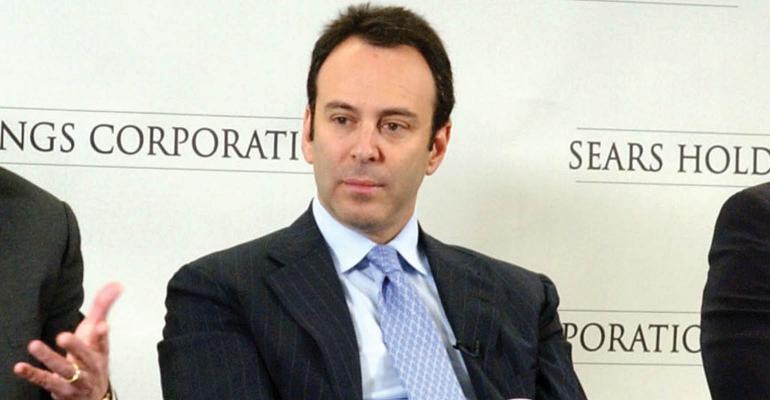(Bloomberg)—Eddie Lampert’s $4.6 billion bid to salvage what’s left of bankrupt Sears Holdings Corp. was pitched by the hedge fund manager as a way to preserve tens of thousands of jobs. To some others in the industry, it’s also seen as a way to sweep a decade of potential problems under the rug.
The bid, if successful, would come with an important condition: a full release from liability over controversial deals his fund made before the 125-year-old retailer filed for Chapter 11 bankruptcy. Those transactions -- a series of spin-offs, rights offerings and refinancings starting in 2012 -- are being probed by both Sears and a committee of unsecured creditors who stand to lose everything in the bankruptcy.
Lampert entities now hold $2.6 billion of loans, making him the company’s biggest creditor. Those claims are key to his bid because he would roll a significant portion of them into equity in a reorganized company. Taking the hedge-fund manager up on his offer would defang the probes into Lampert’s deals, an investigation that so far has caused Sears and others to hand over 400,000 pages of documents.
“The release basically says, ‘If I’m going to pay this amount, you can’t sue me,”’ said Eric Snyder, chairman of the bankruptcy practice at the Manhattan-based law firm Wilk Auslander. “The creditors are between a rock and a hard place. They are loath to give Lampert a release, but they might not have any other offers.”
A spokesman for ESL said the transactions were valid and show the firm’s consistent support for Sears in its efforts to return to profitability amid disruption in the retail industry.
“This support has consisted of a variety of transactions including rights offerings that provided all Sears shareholders the opportunity to invest in businesses separated from Sears Holdings, as well as loans to the company that often involved the participation of third parties,” the representative said in a statement, adding that all transactions were based on fair and reasonable terms and were approved by independent directors.
A Sears representative declined to comment.
Here’s a look at the deals the creditor committee is investigating, according to court filings:
The Leaseback
In July 2015, Sears sold more than 200 of its most valuable real estate assets to a publicly traded real estate investment trust called Seritage Growth Properties and controlled by ESL. The unsecured creditors committee (UCC) has said the properties were sold at what appeared to have been discounted prices and then leased back to Sears on “unfavorable and burdensome terms.” The committee called this the deal it was most concerned with. ESL responded in court papers that the sale was for a fair price set by independent experts and the lease terms were also fair and disclosed before the deal.
Hometown Spinoff
Sears Hometown and Outlet, a retailer selling home appliances, hardware, and garden equipment, was sold by Sears Holdings in October 2012 via a rights offering to existing shareholders. The UCC believes that the market value of Sears Hometown at the time of the deal was significantly higher than the value received by Sears Holdings. ESL disputed in court papers that Sears Hometown was undervalued in the sale and said the deal brought liquidity that allowed Sears to focus on transforming its business.
Sears Canada
Sears spun off its Canadian retail subsidiary to shareholders gradually via various interconnected transactions from 2012 to 2014. Sears Canada liquidated a year ago and about 12,000 people lost their jobs. ESL has said the deal gave Sears the ability to focus on transforming its business.
Lands’ End
In April 2014, Sears Holdings spun off its Lands’ End business via a stock distribution to its shareholders. Following the spinoff, ESL and Lampert owned a majority of both Sears Holdings and Lands’ End. Because of the separation, the clothing retailer, at the time a profitable company, was now isolated from Sears Holdings, which could no longer access its assets or cash flow. In court papers, ESL disputed that the sale undervalued Lands’ End and said that deal also generated cash that allowed Sears to focus on its turnaround.
Other Deals
Since 2017, Sears entered into a number of debt transactions with ESL and affiliates of the fund to preserve liquidity. Many of those deals added to the retailer’s mounting debt load while granting liens on previously unencumbered assets, according to the UCC. ESL responded in court papers to say that the various transactions were fully documented and conducted on fair and reasonable terms. “Any allegation that ESL received ‘sweetheart’ deals is plainly wrongheaded and intended to inflame opinion against ESL,” the filing states.
--With assistance from Eliza Ronalds-Hannon.To contact the reporter on this story: Josh Saul in New York at [email protected] To contact the editors responsible for this story: Rick Green at [email protected] Shannon D. Harrington, Dan Wilchins
COPYRIGHT
© 2018 Bloomberg L.P

